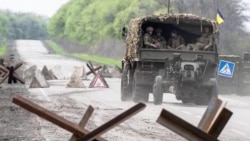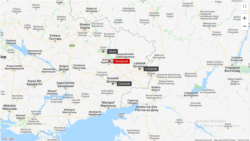On May 24, Russian Defense Minister Sergey Shoigu tried to spin the slowdown of Russia’s military campaign in Ukraine as a means of protecting civilians.
Citing Shoigu, Russian state broadcaster RT said the Russian armed forces in Ukraine are “creating humanitarian corridors and announcing ceasefires to ensure the safe evacuation of residents from encircled settlements.”
“Of course, this slows down the pace of the offensive, but it is being done deliberately to avoid civilian casualties,” Shoigu told a meeting of the Collective Security Treaty Organization (CSTO) Council of Defense Ministers, which includes Russia and other post-Soviet states.
He claimed Ukraine’s armed forces, not the Russian military, are targeting civilian structures. By contrast, he said, Russia is striking Ukrainian military positions and facilities with “high precision weapons.”
Shoigu said the expedited military shipments to Ukraine from the United States and European countries signal fears that Ukrainian forces will be defeated. Despite this, Shoigu said Russia would continue its so-called “special military operation in Ukraine” until “all its objectives are achieved.”
Shoigu’s characterization of Russia’s progress in the war and concern for Ukrainian civilians are misleading.
In fact, abundant evidence shows that Russia has targeted civilian populations and infrastructure, terrifying rather than protecting them. The Ukrainian forces’ fierce resistance and Russia’s losses of heavy equipment and personnel have forced Moscow to scale back both its objectives and operations.
Also abundant: Allegations of Russian war crimes against Ukrainian civilians.
In April, U.N. High Commissioner for Human Rights Michelle Bachelet said international humanitarian law had seemingly been “tossed aside” since Russia’s invasion of Ukraine on February 24.
“Russian armed forces have indiscriminately shelled and bombed populated areas, killing civilians and wrecking hospitals, schools and other civilian infrastructure, actions that may amount to war crimes,” Bachelet said.
Prominent examples include Russia’s bombing of the Mariupol theater on March 16, which an Associated Press investigation found killed 600 people taking shelter there. A week earlier, Russia struck a maternity hospital in Mariupol, sparking international outrage.
Relentless Russian shelling left Mariupol in ruins, likely killing thousands according to Ukrainian accounts. On May 24, workers found 200 bodies in a basement while sifting through the ruins of a destroyed apartment building.
As of May 22, the Bachelet’s office recorded 8,462 civilian casualties in Ukraine — 3,930 killed and 4,532 injured. The office said, as always, it “believes that the actual figures are considerably higher” because of the ongoing fighting.
Mariupol's mayor claimed 21,000 civilians were killed in his city alone.
Across Ukraine, evidence of war crimes emerged after Ukrainian forces regained control of areas previously under Russian occupation.
Most infamously, evidence of rape, torture, and summary execution of civilians was discovered in the Kyiv region town of Bucha after Ukrainian forces liberated it in early April.
U.S. Secretary of State Antony Blinken called Russia’s actions in Bucha “a deliberate campaign to kill, to torture, to rape, to commit atrocities.”
Amnesty International found that “residents of other neighboring towns and villages also experienced serious violations during Russia’s occupation of those areas." Those violations included devastating airstrikes that hit residential apartment buildings, and the extrajudicial execution of civilians after torture.
Human Rights Watch documented “22 apparent summary executions, 9 other unlawful killings, 6 possible enforced disappearances, and 7 cases of torture” in 17 villages and small towns in the Kyiv and Chernihiv regions, which were under Russian occupation from late February through mid-March.
Similar allegations of rape and war crimes are emerging in Ukraine’s east and south, the focus of Russia’s attacks at the moment.
Analysts say Russia’s offensive is slowing down for a number of reasons that have nothing to do with protecting civilians.
On May 23, former Australian army Gen. Mike Ryan tweeted that Russia’s military forces are likely in the short-term to “reach the limit of their offensive capability,” pushing them to transition to “a defensive strategy.”
Ryan noted that “[t]housands of Russians soldiers have been killed or wounded, and hundreds of armored vehicles destroyed in the east of the country. For all this effort, the Russians have gained little additional territory in the past month.”
According to Oryx, a military analysis website that documents equipment losses in the Ukraine war, “Russia is now visually confirmed to have lost 700 tanks since it began its invasion of Ukraine three months ago.”
Russia has lost thousands more vehicles of other types, including 400 armored fighting vehicles.
Russia does not release accurate death statistics for its troops, and Western sources view Ukraine’s estimate of 27,000 Russian troops killed as high, France 24 reported.
On May 23, Britain’s Defense Ministry estimated that, in the three months since invading Ukraine, Russia had likely suffered a death toll similar to what the Soviet Union experienced during its nine-year-long war in Afghanistan – about 15,000.
Some defense analysts have suggested Russia’s war in Ukraine has reached the culminating point — that is, when the attacking force can’t maintain its offensive.
Others dispute this.
“I don't think the Russian offensive looks stalled, and while sluggish, there is no good way to predict when it will culminate,” tweeted Michael Kofman, research program director for the Russia Studies Program at the Center for Naval Analyses.
A senior Pentagon official likewise told Agence France-Presse it might be premature to say that Russia’s campaign has reached a culminating point.
Russia forces maintain numerical and firepower superiority, but they have seen limited breakthroughs. The Pentagon official noted they are maintaining “a long front from the Donbas south and west toward Mykolaiv.”
The capture of Mariupol and the Kherson region has given Russia a land bridge to Crimea, which it illegally annexed in 2014.
Russia’s main focus appears to be on expanding its control over eastern Ukraine. Reports suggest Russia will move to annex the territory it has occupied, possibly through sham referendums, as it did in Crimea.
As with Mariupol, Russia has employed its tactic of indiscriminate destruction in its attempts to capture Severodonetsk, the last city Ukraine holds in the Luhansk province.
“Round-the-clock there is shelling, and unfortunately the Russian army chose the scorched-earth tactic against the city of Severodonetsk: They are simply systematically destroying the city. Everywhere is being shelled constantly,” Serhiy Haidai, governor of Luhansk Oblast, told The Washington Post.
On May 21, Russian forces destroyed a bridge into Severodonetsk, “making it harder to evacuate people and bring in supplies,” the Post reported.
Ukrainian President Volodymyr Zelenskyy accused Russian forces of “trying to destroy all living things” in Ukraine’s east, the Los Angeles Times reported.
“Literally,” Zelenskyy said. “Nobody destroyed Donbas as the Russian military does now.”
The shifting nature of Russia’s offensive is reflected in its evolving aims.
According to the Institute for the Study of War (ISW), Russian forces “have likely abandoned efforts to complete a single large encirclement of Ukrainian forces in eastern Ukraine.” They have shifted to securing “smaller encirclements – enabling them to make incremental measured gains” in the Donetsk and Luhansk regions, the Washington-based think tank reported on May 24.
“Russian forces have secured more terrain in the past week than efforts earlier in May,” the ISW wrote. “However, they have done so by reducing the scope of their objectives – largely abandoning operations around Izyum and concentrating on key frontline towns: Russian performance remains poor.”
Still, with Russia controlling a contiguous piece of Ukrainian territory and a decisive victory unlikely for either side, “signs are growing that the war could become a protracted stalemate,” NPR reported.








